As you may know from previous FB posts and my weekend blog, I recently visited the VMFA during the creation of the Tibetan mandala. As with many special exhibits, the VMFA shop offered many items related to mandalas and Tibetan culture—and thus I became aware of dZi (pronounced Zee) beads for the first time. The Tibetan word “dZi” translates as “shine, brightness, clearness, splendor.” The name in Mandarin Chinese translates as “heaven’s bead” or “heaven’s pearl.” FYI, I’ve seen it written Dzi as well.
The dZi are stone beads worn as part of a necklace or bracelet. Many Asian cultures around Tibet also prize dZi as protective amulets and for positive spiritual benefits. As with many things thought to have good vibes, dZi have and have had multiple uses: ground into powder, they are sometimes used as an ingredient in traditional medicine, and sometimes used as a tool to burnish the gilt on paintings or statuary.
The most highly prized dZi beads are ancient, and made of smooth, natural agate. Those being hard to come by, modern-made dZi are even making inroads in Tibet. The designs can be almost anything: circles, ovals, squares, waves, zig zags, stripes, lines, diamonds, dots, etc. The colors are mainly brown to black with a design in off-white. The number of “eyes” in a design is significant, as is their arrangement.
DZi stones appeared between 2000 and 1000 BCE. Although the geographic origin is unknown, they are now generally known as Tibetan beads. In Tibetan culture these beads are believed to attract protectors, maybe beneficial ghosts or ancestors. Thus the beads are always treated with respect.
As long ago as the early 19th century, “modern era” beads in this style were made in Germany. New dZi have been produced in Asia. The most convincing replicas of ancient beads came from Taiwan during the 1990s, and good-quality ones from mainland China over the last three year.
New beads are less likely to appeal to purists. However, attitudes toward new beads vary widely: some believe the new stones function as well as the old ones; some believe the protective energies are missing but can move into a new dZi under certain circumstances; at the same time, the ancient beads have absorbed energy—both good and bad—from all the previous owners whereas these new beads have no need to be cleansed in the same way. In any case, one should purify one’s beads and ask them to bond with you. There is an interesting and informative article online titled the Myth and Mystery of Tibetan Dzi Stone Beads that tells how to do this, and how to care for your beads in general. It also identifies the meaning attached to the number of eyes on the bead, from one to twenty-one.
Imitation dZi are made from materials other than agate or calcedony—virtually any other material. Some of these imitations were created a couple of hundred years ago. Some of the older mock dZi are valued in their own right. The dZi beads available in the VMFA shop are made of traditional materials (agate) and designs, but they are obviously mass-prodced and thus some would consider them to be imitations.
If one believes in the power of stones, these would still have the positive properties of these varieties of quartz. Agate and chalcedony are two commonly-encountered varieties of quartz.
Agate: all about harmony and balance. Although different varieties/colors of agate have their own properties, all types of agate stones have these agate properties at the heart of their meaning. All agate mineral rocks vibrate or resonate at a slower, less intense rate than some of their more high-frequency quartz relatives. These less intense vibrations impart strength and stability. Agate meaning includes yin and yang energy, providing a balance between the positive and negative.
Carnelian is known as a stone of motivation and endurance, leadership and courage. Carnelians have protected and inspired throughout history. A glassy, translucent stone, Carnelian is an orange-colored variety of Chalcedony, a mineral of the Quartz family.
Chalcedony is a nurturing stone that promotes brotherhood and good will. It absorbs negative energy. It brings the mind, body, emotions and spirit into harmony. Chalcedony instills feelings of benevolence and generosity. It alleviates hostility and transforms melancholy into joy.
Black Onyx is another variety of Chalcedony, which ranges from white-colored stones to black. It is one of the many gemstones believed to have amazing healing and spiritual properties. The story of the origin of this stone varies from culture to culture, but it does go back a very long way in time. Today it is available in pure black, as it is heated and polished.
BOTTOM LINE: Get thee to the VMFA, enjoy the exhibit, and learn a bit about Tibetan culture. You never know what information a writer can use down the line!
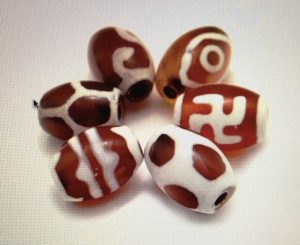
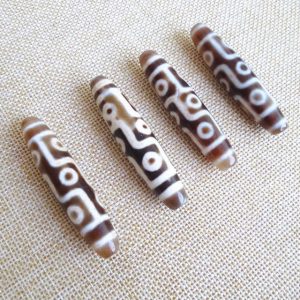
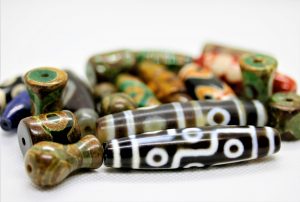
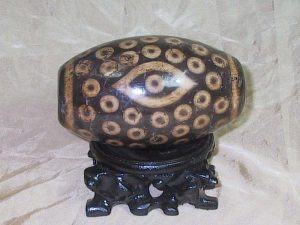
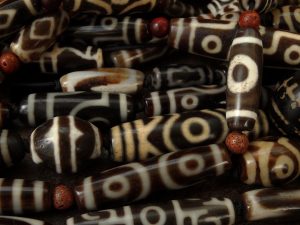
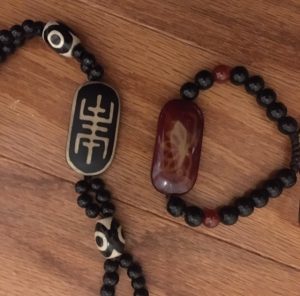
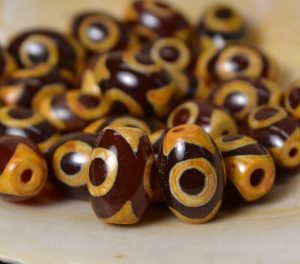
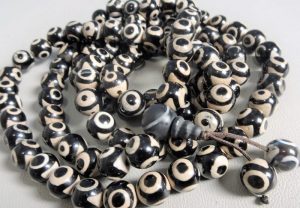
Dzi stones made their first appearance between 2000 and 1000 BC, in ancient India: a few hundred thousand were supposedly brought back by Tibetan soldiers from Persia during a raid. The malicious effect of the “evil eye” was taken very seriously by these people. Dzi were considered to counteract the evil eye. The artisans who made the dzi created amulets with “eyes” on them as a “fight fire with fire” form of protection. Artisans used agate as the base stone, and then embellished the beads lines and shapes using ancient methods that remain mysterious. Treatments may have included darkening with plant sugars and heat, bleaching and white line etching with natron, and protecting certain areas with grease, clay, wax or a similar substance. A hole was drilled before the bead was decorated as drilling caused most breakage during the production process, and holes were also useful for stringing and dipping numerous beads as a step in coloration. The earliest holes were conical and done with solid drill bits drilling from both ends and, hopefully, meeting near the center of the bead. Very small drill tips of chipped flint were used without abrasives and numerous other materials, regardless of hardness, when used with abrasives. Neolithic era beads were also drilled with hollow, tubular abrasion driven bits of reed and, later, during the Chalcolithic, copper. These drilled a hole with a core of agate inside the tubular drill. Tubular bit holes were parallel walled rather than conical, but also done from both ends. Both methods required arduous work done with a bow drill, with time and effort being determined by hardness of abrasive, from ground sand (quartz) to corundum.
Although the geographic origin of dzi beads is uncertain, it is accepted that they are now called “Tibetan beads,” just like “Tibetan coral,” which also came to Tibet from elsewhere. Tibetans cherish these beads and consider them hereditary gems. In this way they have survived thousands of years, being worn by hundreds of individual people. Dzi are found primarily in Tibet, but also in neighbouring Bhutan, Nepal, Ladakh and Sikkim.[citation needed]Although Dzi type agate beads were made in the Indus Valley during the Harappan period and at various locations rich in agate deposits in India, such as in Khambhat, since their Neolithic periods, the earliest archaeologically controlled find of an agate bead with Dzi style decoration of straight and curved lines and circular eye found has been from a Saka culture excavation (Uigarak) in Kazakhstan, dated 7th – 5th C. BCE. These were said to be imports from India, reflecting long distance trade with the more nomadic Saka or Scythian tribes.
Sometimes shepherds and farmers find dzi beads in the soil or in the grasslands. Because of this, some Tibetans traditionally believe or believed that dzi are naturally formed, not man-made
Since knowledge of the bead is derived from several differing oral traditions, the beads have provoked controversy regarding their source, their method of manufacture and even their precise definition.[citation needed] In Tibetan culture these beads are believed to attract local protectors, dharmapalas or deities or maybe beneficial ghosts, ancestors or even bodhisattvas. Because of this, dzi beads are always treated with respect.[1
Somehow your post became buried in a flurry of notifications—for which I apologize!
Thank you for your thoughtful information and permission to use it!